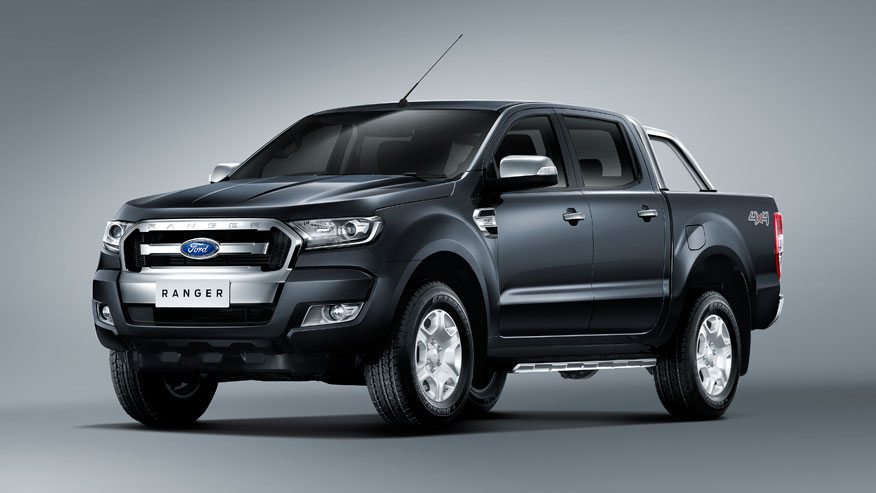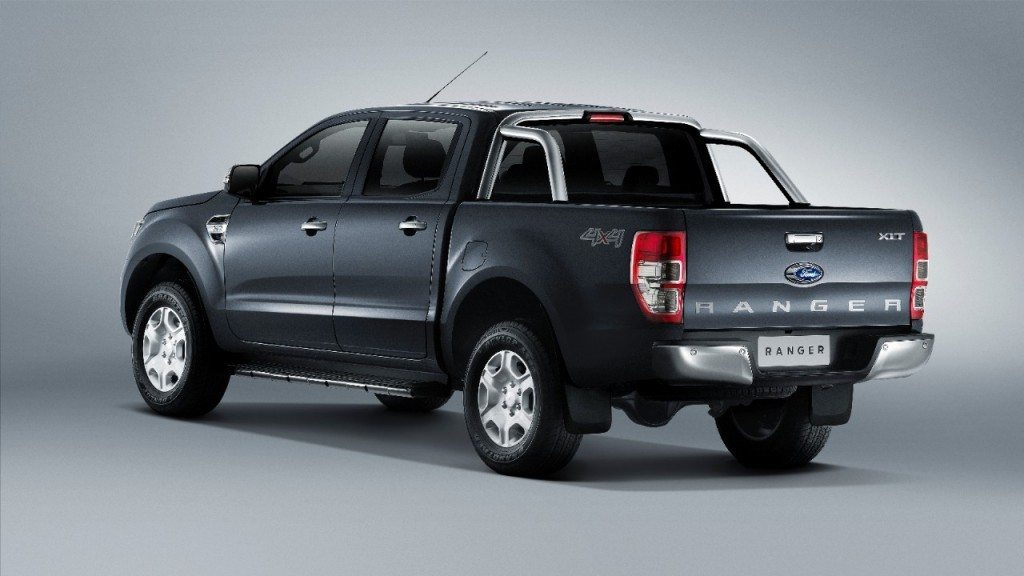“What is THAT handsome thing,” you ask? Oh, just the new Ford Ranger (after a 3 year hiatus from the market). Like what you see? TOO BAD.
For the first time in years, the midsize pickup market is heating up. Limited to just two models a year or two ago (the Nissan Frontier and Toyota Tacoma), the segment has suddenly doubled in size, and it looks like it’s about to get even more crowded. The new Chevy Colorado won Motor Trend’s 2015 Truck of the Year award, and because of its success, General Motors is having a hard time keeping the Colorado (and the nearly identical GMC Canyon) in stock at dealerships. An all-new Toyota Tacoma is on the way, and Hyundai could be preparing an entry into the segment with its diesel-powered Santa Cruz concept. In the midst of this midsize expansion, there’s one name that’s notably absent from the field. For nearly 30 years, the Ford Ranger was a leader in the segment, only to be discontinued in 2012 without replacement. Well, the good news is that a new Ranger is coming – and sadly, it’ll be available just about everywhere but the United States.
Known internally as the T6, Ford’s international Ranger model debuted in 2010 as a rugged go-anywhere truck designed to compete with the Toyota Hilux and the Volkswagen Amarok – rugged midsize trucks available basically everywhere but in the U.S. and Canadian markets. Built in Thailand, South Africa, and Argentina, the T6 Ranger is sold in 180 countries (including Mexico), but Ford believes the truck is too similar to the F-150 to consider selling it stateside. And these fears might not be unfounded – in Mexico, the current Ranger Limited four-door starts at roughly $26,400. In the U.S., a comparable four-door F-150 starts at $30,695.
Even with its entry-level price, buyers get a lot of truck in the Ranger, and they’re about to get a whole lot more. Two diesel engines are available: a torquey 197 horsepower 3.2 liter five-cylinder (geared for towing), and a 160 horsepower 2.2 liter four-cylinder. Six-speed manual or automatic transmissions are offered for both engines, and are geared for maximum fuel economy. The revised gear ratios combined with a stop-start system (which turns the car off at idle) help to give the new truck an estimated 15% increase in fuel economy compared to the outgoing model.
The new Ranger also ditches a standard power steering setup with an all-electric system that Ford claims will reduce fuel consumption by an additional 3%. The truck has a class-leading nine inches of ground clearance, and can power through nearly two-and-a-half feet of water. A redesigned front fascia contributes to a 28 degree approach angle, and combined with a 25 degree departure angle and revised suspension with better on-road manners, there aren’t many stock trucks in the world that can boast the off-road capabilities of the Ranger.
Changes continue on the inside as the Ranger’s interior moves upscale. Clad in durable plastics and fabrics with handsome aluminum accents, Ford says the truck’s interior was designed to be more car-like while maintaining the durability of a work truck. With an all-new instrument panel similar to the one found on the American Explorer and Edge SUVs, the Ranger is also equipped with Ford’s revised SYNC 2 infotainment system. Despite being a workhorse designed for some of the toughest conditions on Earth, the Ranger can also be optioned with a host of gadgets that wouldn’t be out of place on any 2015 vehicle. Lane-departure warning, adaptive cruise control, and parking sensors are all offered on the truck. Pricing isn’t available yet, but a fully-loaded Ranger will probably top out far below the $50,000-plus F-150 Platinum.
This adds up to a thoroughly modern truck that’s a far cry from the stereotype of the primitive workhorse that many Americans have when they think of foreign trucks. This is largely because the American marketplace has been kept from the majority of foreign-built trucks for decades. In 1963, the U.S. Government imposed a 25% tariff on imported starches, brandy, and light trucks in response to a tariff on American chicken by Great Britain and France. This inexplicable law became known as the “Chicken Tax,” and is a major reason why most international automakers don’t offer their pickups in America. Heavy import fees, and the increasingly strict Corporate Average Fuel Economy standards all but reduced the small and midsize pickup market to mostly American-built trucks by the early 1990s, and when the market bottomed out by the late 2000s, it was all but left for dead.
But now, things have changed. The midsize pickup market may be growing bigger than its name suggests, but sales are heating up, and that could prove to be too much for other automakers to ignore. In an interview with USA Today last October, Ford’s truck marketing manager Dave Scott said Ford is looking at the segment, and the company could be making a return to it in the next few years. “We think we could sell a compact truck that’s more like the size of the old Ranger, that gets six or eight more miles per gallon (than a full-size truck), is $5,000 or $6,000 less, and that we could build in the U.S. to avoid the tariff on imported trucks.” While that truck could have a Ranger badge on it, it almost certainly won’t be this one – and that’s a shame.
Ford has a fantastic truck in the F-150, and it looks like it has another hit on its hands in the new Ranger. If Ford decides to build a new small truck for the American market, it doesn’t have just the F-150 to live up to, it’ll also have to contend with the forbidden fruit that is the Ranger.
Lamarque Ford is proud to be one of the premier dealerships in New Orleans, LA. Located in Kenner, LA, Lamarque Ford is committed to providing you the best customer service and vehicle service for the life of your vehicle. Whether you’re on the market to purchase, finance, or service a new or used Ford vehicle, you’ve come to the right place.



Leave a Reply